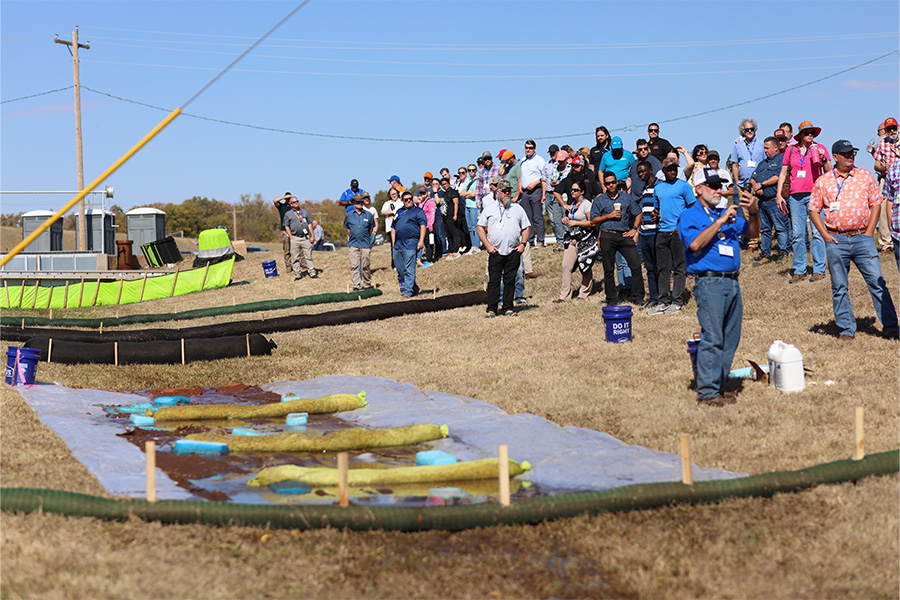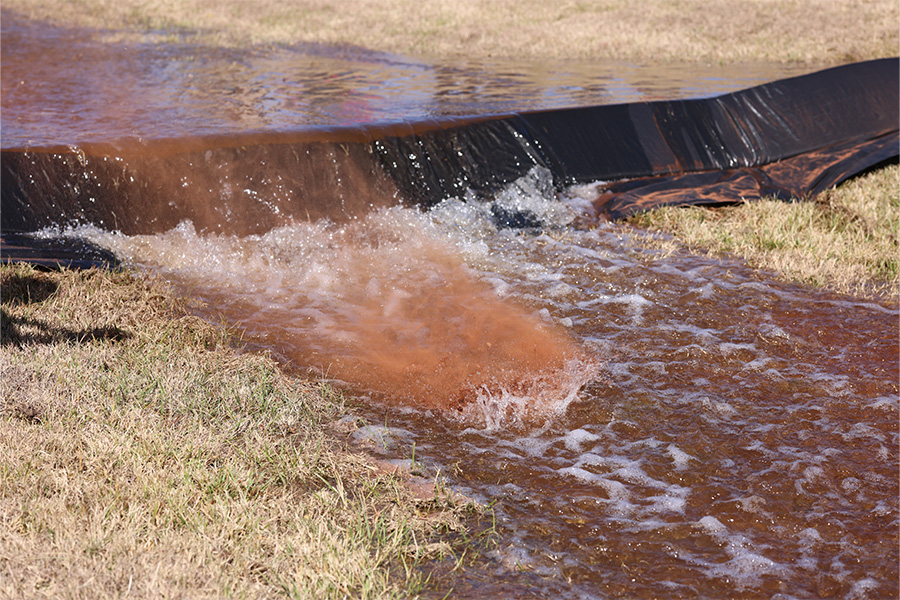 CIVE research focuses on resilient erosion, sediment control for construction sitesMonday, April 14, 2025 Media Contact: Tanner Holubar | Communications Specialist | 405-744-2065 | tanner.holubar@okstate.edu Researchers at Oklahoma State University’s School of Civil and Environmental Engineering, part of the College of Engineering, Architecture and Technology, are collaborating on a multi-university research project to enhance the resiliency of erosion and sediment control practices employed on state Department of Transportation construction sites. Dr. Jaime Schussler, an assistant professor in CIVE, has partnered with researchers from Auburn University and the University of Tennessee-Knoxville, as well as consultants from Fagan Consulting and JEO Consulting on a research project funded through the National Cooperative Highway Research Program. The team will develop guidelines for selecting, placing, designing and maintaining the best practices for managing erosion and sediment, although Schussler notes that managing erosion and sediment starts with people. To improve current practice, the team will evaluate design modifications to reduce risks of failure and enhance resilience. To get the research results into the hands of practitioners, the team will create design tools, host workshops and report to an NCHRP panel to get feedback from those in the construction space. This research will provide deeper insight into the current practice while working toward more resilient design and installation methods. New design and installation methods will be vetted through full-scale controlled performance tests and modeling efforts. This research aims to influence guidelines related to erosion prevention and sediment control practices to make them more resilient and provide tools to ease adoption on-site. This project defines resilience as an erosion and sediment control practice that can withstand or adapt to change and function as it was designed with little to no performance loss. A stormwater pollution prevention plan, which includes erosion and sediment control practices, is required for any construction site disturbing more than one acre. These sites can be complex, as they are constantly evolving through the earthwork stages. Each site is different, with a variety of soils, rainfall patterns, and slopes, among other things. This requires a site-specific plan to prevent erosion and manage the sediment before offsite discharge.  During grading activities, the existing land is stripped and shaped, leaving soil exposed to the elements. Without any cover, such as vegetation, the soil is then susceptible to being eroded by wind and rain. When it rains, loose soil is then entrained in runoff and transported downstream. If not managed onsite, the suspended sediment can then settle in receiving waterways, having profound environmental impacts, including inhibiting aquatic habitats. Schussler’s team is working toward improving environmental stewardship and minimizing the risk of harmful offsite discharge. “Whatever we are doing, we want to make sure we are good stewards of that site, which includes trying to limit the sediment leaving the site and minimize downstream pollution,” Schussler explained. “The erosion control is so important. If you can stabilize the site and prevent the erosion, then you don’t have to worry about the sediment transport as much." Another major concern of offsite sediment-laden discharge is that the sediment can serve as a vessel for other harmful pollutants to enter waterways. These pollutants, such as nutrients and metals, can stick to the sediment and then impact the quality of the water. “When the water looks muddy running off the site, we call that turbidity. Elevated turbidity alone can be harmful to water quality,” Schussler explained. “Specifically, turbid water can impact aquatic species' feeding, spawning and migration. Additionally, it puts a lot more 'stuff' in the water that would need to be removed in the treatment process, which is energy and cost intensive. Even if those particles settle out in the receiving waters, the sediment takes up a lot of volume, which reduces the storage and conveyance capacity of our lakes and streams.” Barry Fagan, of Fagan Consulting LLC, is serving as an advisor on the project and is the developer of the Five Pillars of Construction Stormwater Management framework, which will be the anchor throughout the project. The Five Pillars include Managing Communication, Managing Work, Managing Water, Managing Erosion and Managing Sediment. The implementation of the pillars, in that order, is the most effective and economical way to mitigate site erosion, minimize sediment discharge and avoid downstream issues. Schussler’s team is in the early stages of this research, which involves studying the current design guidelines and methods used in the industry, surveying state DOTs and learning from their case examples. Schussler is working toward developing a framework for design guidelines that incorporate risk and resiliency factors, which will be informed by project findings. The team is starting the second phase of the project, which focuses on developing research methods and results for resilient erosion and sediment control practices. The performance-based data will then be implemented into design guidelines. The researchers will operate under an NCHRP advisory panel, made of state DOT practitioners to review and guide research directions. Schussler enjoys that this project will result in tangible, usable outcomes that result from the industry having a stake in this research.  “It is great to have performance-driven designs. It means that we’ll have data to back up our “best” management practices,” Schussler said. “A lot of people say you cannot replicate field conditions, and it is hard to do because construction sites are super dynamic. You have different soil types, rainfall amounts, and topography just to name a few. A lot of the research we’ll be doing is replicating field conditions at Auburn’s outdoor lab, where we can get close to full scale. This will give us a lot of information about how the practices will perform onsite — although there is always more to learn in the field.” Erosion and sediment control research is where Schussler formed her stormwater expertise but has primarily used that knowledge for training and outreach efforts in Oklahoma. Since joining OSU, she has been mostly involved in research on the post-construction and infrastructure side of stormwater. She is enjoying getting back to her roots and working with a team that she’s known for years — dating back to when she was a graduate student at Auburn. The project has a three-year timeline, but Schussler is already excited about the results and implementation. “The coolest part of this project is that we’re getting feedback from practitioners, the people using the erosion and sediment control practices in the field,” Schussler said. “Our panel is reviewing each step of the research and advising us so that risk and resilience-oriented erosion and sediment control practices can be more reliably and easily implemented by the close of this project.” (Source: https://news.okstate.edu/articles/engineering-architecture-technology/2025/cive_research_focuses_on_reslient_erosion_for_construction.html) |